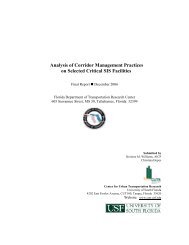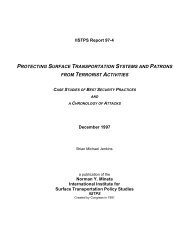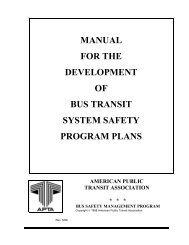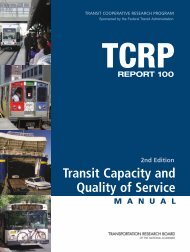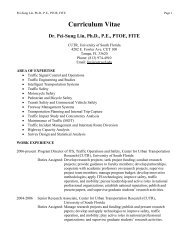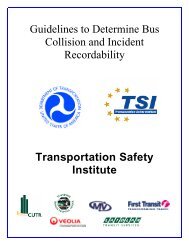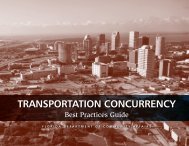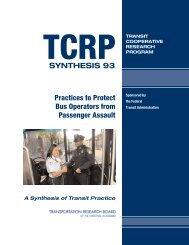a technical guide for conducting pedestrian safety assessments
a technical guide for conducting pedestrian safety assessments
a technical guide for conducting pedestrian safety assessments
Create successful ePaper yourself
Turn your PDF publications into a flip-book with our unique Google optimized e-Paper software.
UNIVERSITY OF CALIFORNIA BERKELEY • INSTITUTE OF TRANSPORTATION STUDIES • TECHNOLOGY TRANSFER PROGRAM<br />
31<br />
J. Focus Groups (Interviews)<br />
Focus Groups or Small Group Interviews may be conducted be<strong>for</strong>e or after a standard Walking Audit to obtain<br />
additional in<strong>for</strong>mation regarding the context, constraints, and opportunities <strong>for</strong> a Focus Area(s). Focus Groups can be<br />
especially helpful when paired with a Target Citizen Group Walking Audit. In this case the target group representatives<br />
can participate in a more in-depth debrief of the Walking Audit and brainstorm potential solutions.<br />
Materials Required: Appropriate meeting room <strong>for</strong> Focus Group size (10-15), flip chart and markers, tape, nametags,<br />
aerial photographs of Focus Area(s), camera, computer and projector (as needed)<br />
Potential Participants: Target group representatives may include:<br />
➜ School District Representatives<br />
➜ PTA Representatives<br />
➜ School Children<br />
➜ Senior Citizens or their Advocates (such as AARP)<br />
➜ Disabled Citizens or their Advocates<br />
➜ Representatives from non-English Speaking Communities (and a translator if necessary)<br />
➜ Civic, Neighborhood, Business Associations<br />
Standard Walking Audit participants can be invited to participate in the Focus Groups, especially those responsible <strong>for</strong><br />
planning and/or implementing <strong>pedestrian</strong> improvement measures.<br />
2.5 IDENTIFY PEDESTRIAN IMPROVEMENT MEASURES (BEST PRACTICES)<br />
The evaluators will make recommendations <strong>for</strong> site-specific and citywide <strong>pedestrian</strong> improvements based on the findings<br />
from the field audits/reviews and data analysis. Some examples of best practices are shown in Table 7. The evaluators<br />
will also consult published standards, best practices, and <strong>safety</strong> resources as shown below in Table 8. Table 8 is<br />
mapped to the FHWA Pedestrian Road Safety Audit Prompt Lists, as shown in Appendix B, to facilitate the use of<br />
Table 8.



